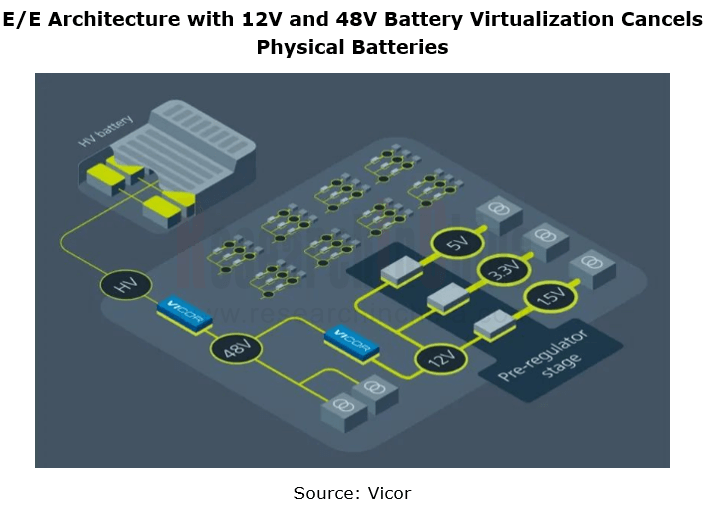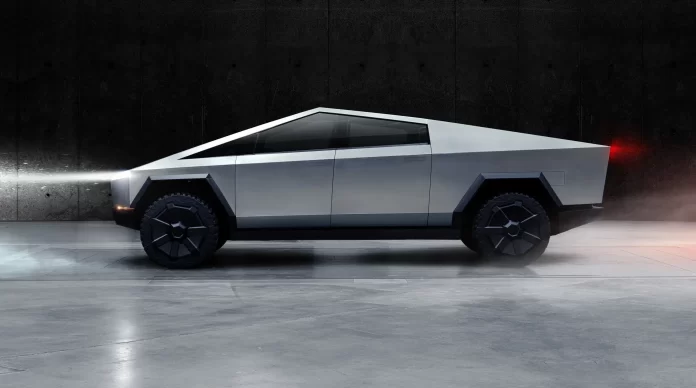Automotive low-voltage PDN architecture evolves from 12V to 48V system.
Since 1950, the automotive industry has introduced the 12V system to power lighting, entertainment, electronic control units and other low-power electronic devices in automobiles. In 2011, Audi, BMW, Daimler, Porsche and Volkswagen jointly launched a 48V system, and formulated the standard LV148 to meet the increasing demand for vehicle loads and stricter emission regulations.
-Use a DC/DC converter to integrate the 48V system on the original 12V system, so that 48V and 12V components coexist.
-Use a DC/DC converter to convert high-voltage electricity from power batteries into 12V and 48V to drive different components respectively.
In November 2023, Tesla officially delivered Cybertruck. Increasing the voltage of the low-voltage battery to 48V can ensure the high power required by vehicle appliances, and also reduce energy loss and heat generation in the circuit, which has obvious advantages over the 12V system.
Cybertruck is of great significance. Tesla also plans to incorporate the 48V system into Model Y in late 2024. Tesla’s strong lead may trigger a revolution of automotive low-voltage PDN architecture.
There are mainly two 48V low-voltage PDN technology development routes:
(1) 12V+48V redundant system
Currently, conventional 48V mild hybrid systems use an electrical topology in which 48V and 12V components coexist. In the future, 48V may act as the third voltage rail of the distribution system of more battery electric vehicles in addition to mild hybrid vehicles. Three rails (HV, 48V and 12V) will coexist on the same vehicle, and some medium-power (1kW-10kW) loads can run in the 48V power supply system.
Also automotive 12V lead-acid batteries are about to withdraw from the market. Europe has issued a decree indicating that all new cars should no longer use lead-acid batteries beyond 2030, which poses a very big challenge to OEMs seeking alternative solutions. At present, 12V lithium batteries have been fully adopted by BYD and Tesla in cars.
Furthermore, the virtual E/E architecture proposed by Vicor directly eliminates 12V/48V physical batteries, thus reducing the weight and cost of the xEV. The E/E architecture features 12V and 48V battery virtualization based on BCM6135 and NBM2317 modules. The 48V bus also serves as a more efficient source for powering higher loads in a vehicle such as the A/C condenser, water pump and active chassis stabilization systems.

(2) 48V system
In Cybertruck design, Tesla plans to completely discard the 12V power supply and bring all the electrical equipment on the vehicle into the 48V working scope. Tesla will use a zone controller as a 48V hub to then power other controllers. Without the supply chain support, Tesla has redesigned a large number of ECUs by adding power protection device, 48V E-Fuse, high-side switch and so on.

48V systems still face a long-term supply chain deployment cycle, which will bring huge potential demand.
The power that a 12V system can provide is up to 3kW-4kW, so automakers can only integrate a certain number of new electrical devices by constantly reducing the power of electrical equipment.
The wiring harness of 48V PDN architecture can support higher-power electrical appliances. For auto parts have long been developed and designed on the 12V, suppliers have to redesign components, including circuits, chip protection voltages and diagnostics, for the sake of 48V. They also need to set standards for 48V and redo reliability experiments, EMC, etc.
The impacts of 48V on the components supply chain include:
1. Zone controllers coupled with 48V eFuse serve as the vehicle power distribution hub.
Zone controllers simplify the migration to 48V architecture. According to Tesla’s design, the vehicle with zone controller architecture only needs a battery as the power supply, which can provide 48V voltage and distribute the power to zone controllers. In the configuration, the zone controllers can provide 48V voltage to the adaptive components, and also reduce the voltage to 12V for other unsuitable components.
In current stage, there are two semiconductor-based eFuse power distribution solutions by application scenarios:
Driver IC-based MOSFET discrete solution: it is suitable for constant current circuits. This solution combines a range of built-in protection functions such as overvoltage, overcurrent, short circuit and thermal protection. The current limit of the overcurrent protection can be set directly via software, which facilitates platform-based hardware application and is applicable to high current situations. The standard threshold of a single smart MOSFET in the automotive industry is 30A. In actual design, >30A high current applications are still mainly fuses + relays.
Intelligent high-side driver (HSD) switch integration solution: it integrates driver + MOSFET + current detection + thermal protection + voltage protection + EMC + diagnostics on a single chip, and is suitable for non-constant current circuits. This solution is still limited to low current load applications (<25A), with low cost and high reliability.
2. Steer-by-wire (SBW), electric power steering (EPS) and rear wheel steering motors are connected to 48V.
Vehicle electrification has increased the number and power of electrical components in vehicles, making the voltage of the automotive power supply prone to fluctuation, thus affecting the control accuracy of steer-by-wire. The design and control of brake-by-wire systems therefore need to be matched with higher-voltage automotive power supplies (e.g., 48V). For autonomous driving at L3 and above, the redundant EPS system has new requirements for 48V steering motors which can provide a quicker response to 48V systems.
According to the Steer-by-wire Technology Roadmap Exposure Draft released in April 2022, the overall goal is to realize the world’s leading steer-by-wire for L3+ and L4+ autonomous driving in 2025 and 2030, with the penetration of steer-by-wire up to 5% and 30%, respectively.
3. Fully active suspension has been mass-produced for 48V hybrid electric vehicles, and will be introduced into battery electric vehicles.
The air suspension often seen in high-performance new energy vehicles is semi-active. The fully active suspension with better performance includes the 48V E-ABC system on Mercedes-Benz GLE, the 48V electromechanical coupling active suspension system on Audi A8, and the “Skyride” fully active suspension on NIO ET9, all of which adopt 48V loads supporting high power.
Mercedes-Benz GLE and Audi A8 boast 48V mild hybrid power systems, which independently control the four-wheel suspension via 48V pressure pumps and ADS+ pressure regulating valves.
ET9, the first model based on NIO’s all-electric platform NT3.0, integrates three core hardware systems (steer-by-wire, rear wheel steering and fully active suspension) for the first time. NIO ET9 supports both 12V and 48V systems, that is, two 12V systems plus a 48V system in the vehicle system. The 48V system is specially designed to support high-power loads, such as fully active suspension (FAS).
4. Redundant topology of 12V/48V power supply
Tesla expects to completely eliminate the 12V power supply and realize intelligent power distribution through zone controllers, which is too radical for most OEMs. The coexistence of 12V and 48V power supply networks and the DC/DC conversion may still be preferred by most OEMs.
12V buses continuously supply power to ignition, lighting, infotainment and audio systems, while 48V buses powers active chassis system, air conditioning compressor, adjustable suspension, electric supercharger, turbocharger and even regenerative brake.
From the perspective of high-level autonomous driving redundancy systems, most conventional vehicles only have a single-circuit main power supply system. When the single-circuit power supply system can’t provide power due to failure, the electrical loads of the vehicles, including autonomous driving systems, can’t work normally. For the vehicles that are in the autonomous driving mode, there is a risk of losing control. In this case, 12V and 48V redundant power supply networks come into being.
In addition, the potential impacts of 48V on the components supply chain are reflected in super-high-compute central computing units, low-voltage intelligent power distribution units, low-voltage wiring harness units, 12V/48V lithium batteries and BMS, 48V DC/DC converters, 48V micromotors, 48V braking systems, 48V cooling fans, 48V electronic water/oil pumps and more. In a word, 48V low-voltage PDN architecture will have a fairly profound impact on the automotive industry.

